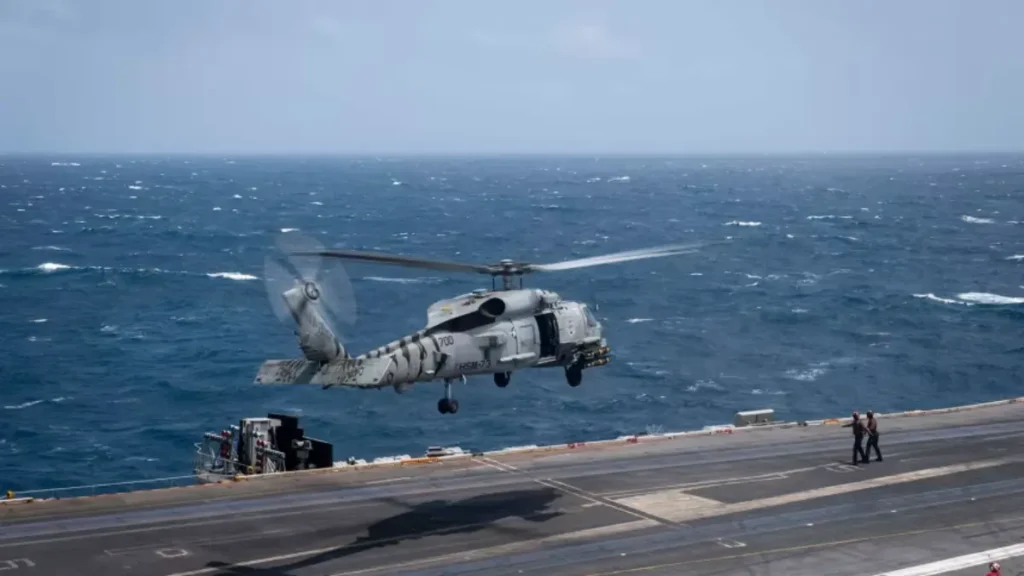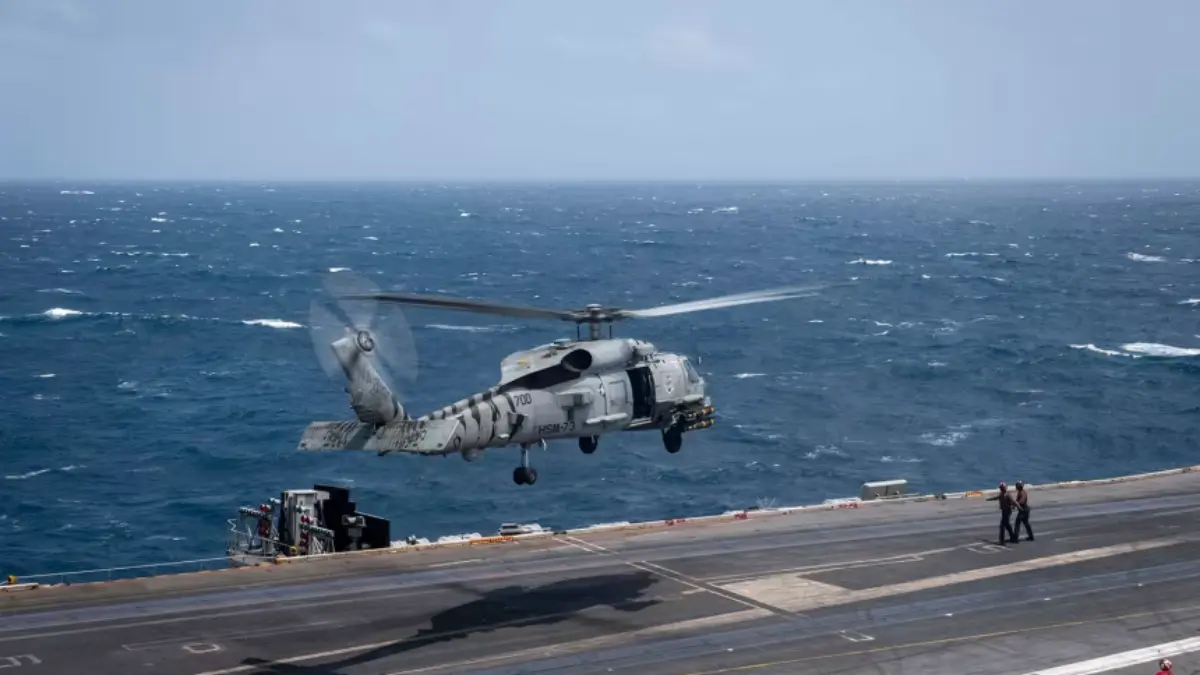A US Navy helicopter and a fighter jet crashed in separate incidents during routine operations in the South China Sea. All crew members were rescued. Here’s what we know about the events, the investigation, and the broader military context.
US Navy Helicopter and Fighter Jet Crash in Separate Incidents in the South China Sea

In a highly unusual development, the United States Navy experienced two aircraft crashes in rapid succession over the contested South China Sea. The dual mishaps—a helicopter and a fighter jet—occurred during routine operations from the carrier USS Nimitz, prompting questions about equipment, operational risk, and regional tensions. Both incidents have triggered formal investigations as officials seek to determine the root causes of the event.
Summary of the Incidents
According to statements from the U.S. Pacific Fleet, the US Navy helicopter and fighter jet crash occurred on Sunday afternoon during standard flight operations launched from the aircraft carrier. At approximately 2:45 p.m. local time, an MH-60R Seahawk helicopter assigned to the carrier went down while conducting routine operations. Shortly thereafter, about 30 minutes later, an F/A-18F Super Hornet fighter jet took part in a separate crash in the same region. Navy Times Business Insider+1
Both crews were rescued, with three personnel from the helicopter and two from the fighter jet safely recovered. Axios The abrupt occurrence of both events has raised eyebrows, given the rare nature of simultaneous aviation mishaps in the same carrier strike group.
Timeline & Key Details
| Time (Local) | Aircraft Type | Squadron / Carrier | Crew Recovery Status |
|---|---|---|---|
| ~2:45 p.m. | MH-60R Seahawk (Helicopter) | HSM-73 “Battle Cats”, USS Nimitz | 3 crew members rescued |
| ~3:15 p.m. | F/A-18F Super Hornet (Fighter) | VFA-22 “Fighting Redcocks”, USS Nimitz | 2 aviators ejected & rescued |
The table illustrates the rapid succession of the dual events. Given the proximity in time and location, the US Navy helicopter and fighter jet crash theme has become the focal point of internal and external scrutiny.
Operational Context & Location
The South China Sea remains one of the world’s most strategically contested waterways, with overlapping territorial claims involving Taiwan, Vietnam, Philippines, and others. The U.S. Navy conducts frequent “freedom-of-navigation” operations in the region to challenge excessive maritime claims. Newsweek+1
The USS Nimitz and its Carrier Strike Group 11 operate in this high-tension environment. The fact that a helicopter and fighter jet crashed within 30 minutes during routine operations adds to the seriousness of the US Navy helicopter and fighter jet crash narrative.
Rescue & Safety Response
Prompt search-and-rescue (SAR) operations by carriers and escorts aided in the successful recovery of all five crew members involved. The Navy confirmed all personnel are “safe and in stable condition.” ABC7 Los Angeles+1
The swift rescue highlights the effectiveness of standard protocols. Nevertheless, the underlying causes of the US Navy helicopter and fighter jet crash remain unclear, and both incidents are under investigation.
Possible Causes Under Investigation
While no official cause has yet been released, analysts and officials are considering multiple possibilities:
- Mechanical or structural failure of one or both aircraft
- Fuel contamination or delivery issues
- Operational error under routine conditions
- Environmental or weather-related impact
- Linkages to carrier operations or maintenance stress
Given the concurrent timing, there is speculation about whether the two crashes are related, despite being classified as separate incidents. The mention of fuel or supply anomalies is gaining traction.
Military & Geopolitical Implications
The US Navy helicopter and fighter jet crash occurs against a backdrop of heightened U.S.–China military competition in the Indo-Pacific. Because both incidents occurred in contested waters, they may reverberate beyond aviation safety and into broader strategic signalling.
Possible implications include:
- The optics of U.S. carrier air wing mishaps in the region
- Shipboard aviation risk mitigation in contested environments
- Chinese monitoring or reaction to U.S. naval aviation incidents
- Reassessment of readiness, training, and maintenance protocols
Historical Pattern & Previous Incidents
Carrier-based aviation is inherently hazardous. For context:
- Previous loss of F/A-18 aircraft (including recent losses from other carriers) make this event part of a broader trend. Business Insider+1
- The fact that two separate incidents occurred so closely in time is rare and underscores the significance of the US Navy helicopter and fighter jet crash series.
What’s Next: Investigation & Fleet Review
In the coming weeks, the following actions are expected:
- Formal investigation by the Naval Safety Center and Pacific Fleet
- Review of both aircraft maintenance records, fuel supply chain, and operational logs
- Assessment of carrier deck operations and flight launch/recovery procedures
- Public release of interim findings once the investigation concludes
FAQs US Navy helicopter and fighter jet crash
Q1. What exactly happened in the US Navy helicopter and fighter jet crash incidents?
A helicopter (MH-60R Seahawk) and a fighter jet (F/A-18F Super Hornet), both launched from the USS Nimitz, crashed in separate events roughly 30 minutes apart over the South China Sea. All crew members were rescued.
Q2. Were there any casualties?
No fatalities or serious injuries have been reported; all five crew members are in stable condition from their rescues.
Q3. What types of aircraft were involved?
An MH-60R Seahawk helicopter assigned to Helicopter Maritime Strike Squadron 73 and an F/A-18F Super Hornet assigned to Strike Fighter Squadron 22. Business Insider+1
Q4. Why is this incident significant?
The occurrence of two separate aviation mishaps in the same carrier strike group, within minutes of each other in a contested region, raises questions about operational risk and maintenance practices.
Q5. What are the strategic implications?
Given the location in the South China Sea and the contested nature of that theatre, these incidents could have broader ramifications for U.S.–China military relations and maritime security posture.
Conclusion
The double events of the US Navy helicopter and fighter jet crash mark a sobering moment for carrier-based aviation and U.S. naval operations in the Indo-Pacific. While all crew members were safely recovered—thanks to rapid response and robust rescue protocols—the occurrence reminds us of the inherent risks of military aviation, especially in contested environments like the South China Sea.
As the investigations proceed, there will be keen interest in the root causes—whether mechanical failure, human error, or systemic operational issues. For now, the U.S. Navy will likely review its carrier air wing procedures, maintenance regimes, and readiness assumptions. Meanwhile, the strategic theatre remains watchful, for any hint that these incidents might influence broader maritime posture.
In sum, the US Navy helicopter and fighter jet crash narrative is not just about two aircraft lost—it’s about readiness, regional presence, and the ongoing challenge of maintaining operational safety under complex conditions.

